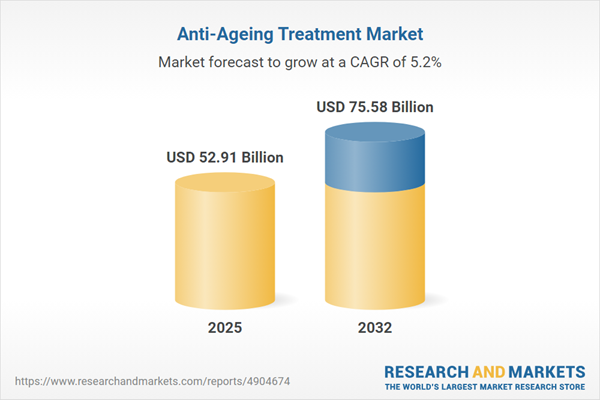Speak directly to the analyst to clarify any post sales queries you may have.
The anti-ageing treatment market is moving rapidly, with emerging technologies and changing patient preferences steering new priorities for providers and investors. Leaders seeking to secure a competitive edge must act decisively and respond to these shifts, as the sector continues to redefine best practices and strategic investments.
Market Snapshot: Anti-Ageing Treatment Market Overview
The anti-ageing treatment market is experiencing robust expansion, supported by a global emphasis on preventive healthcare and overall wellness. Digital health integration is transforming market dynamics, streamlining patient access and interaction. Service models are adapting to offer personalized experiences, keeping pace with evolving patient needs and regulatory complexity. Major corporations and new entrants are recalibrating their portfolios and operating strategies to address distinct regional regulations and varied consumer expectations. Digital innovation, together with regional value chains and local market nuances, is unlocking new opportunities while introducing additional layers of operational complexity.
Scope & Segmentation
- Treatment Types: Chemical peels, cryotherapy, dermal fillers, botox injections, laser resurfacing, microdermabrasion, microneedling, radiofrequency-based therapies, and topical formulations are deployed for both preventative and corrective care, targeting diverse age groups and skin needs.
- Gender Segmentation: Brands tailor product features and communications to serve male and female audiences, fostering targeted engagement and stronger brand loyalty.
- Distribution Channels: Digital health platforms, branded retail outlets, online marketplaces, pharmacies, and specialist beauty retailers ensure adaptable access based on regional infrastructure and consumer behavior.
- End User Applications: Innovations serve facial, body, and eye care areas, with precise solutions tailored to the requirements of various demographics.
- Geographic Coverage: The market addresses the Americas, Europe, Middle East, Africa, and Asia-Pacific, responding to distinctive regulations, consumer perspectives, and operating environments in each region.
- Company Analysis: Leading organizations such as L'Oréal S.A., The Procter & Gamble Company, Estée Lauder Companies Inc., Unilever PLC, Shiseido Company, Johnson & Johnson, Amorepacific, Beiersdorf AG, KAO Corporation, and LG Household & Health Care Ltd. prioritize digital transformation and active product development to remain aligned with evolving market demands.
Key Takeaways: Strategic Insights for Senior Decision-Makers
- Organizations are emphasizing agility to enhance operational efficiency and patient satisfaction, favoring minimally invasive treatment options in anti-ageing care.
- The integration of teleconsultation and digital health capabilities strengthens engagement, expanding interactions beyond traditional clinical settings and enabling smoother patient journeys.
- Refined communication strategies—adapted by treatment and gender—drive more relevant consumer relationships, boosting loyalty and distinct market positioning.
- Procurement and supply chain adjustments, fueled by compliance and sustainability shifts, reinforce organizational flexibility and readiness in the face of new regulatory challenges.
- Collaborative partnerships across pharmaceutical, technology, and biotechnology sectors are accelerating product advancement and bolstering adaptive commercial strategies throughout the anti-ageing treatment landscape.
- Growing integration of direct-to-consumer channels allows for broader brand engagement, supporting competitive differentiation as market rivalry intensifies.
Tariff Impact and Supply Chain Evolution
With ongoing US tariffs affecting imported anti-ageing equipment and components, companies are overhauling global supply approaches. Tactics such as nearshoring, onshoring, and establishing resilient regional supplier networks aim to curb geopolitical and cost risks. These adaptive strategies help uphold uninterrupted product availability and support business continuity, ensuring the market remains resilient even amid external challenges.
Methodology & Data Sources
This report is grounded in insights drawn from industry experts, manufacturing partners, supply chain stakeholders, and service providers. Analysis is built on peer-reviewed research, patents, white papers, and regulatory records to ensure actionable and reliable guidance for senior decision-makers in the anti-ageing treatment sector.
Why This Report Matters
- Enables senior leaders to make informed investments and strategic decisions through nuanced, actionable market intelligence aligned with sector dynamics.
- Clarifies regulatory considerations and technology developments, supporting compliance and proactive risk management throughout market cycles.
- Equips organizations with recommendations for adapting to shifting consumer tastes and heightened marketplace competition, ensuring preparedness and strategic resilience.
Conclusion
Sustained growth in the anti-ageing treatment market will depend on adaptive strategies and continuous collaboration. Leaders who anticipate changes in technology and evolving consumer priorities can best position their organizations for future opportunity and market advancement.
Additional Product Information:
- Purchase of this report includes 1 year online access with quarterly updates.
- This report can be updated on request. Please contact our Customer Experience team using the Ask a Question widget on our website.
Table of Contents
3. Executive Summary
4. Market Overview
7. Cumulative Impact of Artificial Intelligence 2025
Companies Mentioned
The companies profiled in this Anti-Ageing Treatment market report include:- L'Oréal S.A.
- The Procter & Gamble Company
- Estée Lauder Companies Inc.
- Unilever PLC
- Shiseido Company, Limited
- Johnson & Johnson Services, Inc.
- Amorepacific Corporation
- Beiersdorf AG
- KAO Corporation
- LG Household & Health Care Ltd.
Table Information
| Report Attribute | Details |
|---|---|
| No. of Pages | 196 |
| Published | October 2025 |
| Forecast Period | 2025 - 2032 |
| Estimated Market Value ( USD | $ 52.91 Billion |
| Forecasted Market Value ( USD | $ 75.58 Billion |
| Compound Annual Growth Rate | 5.2% |
| Regions Covered | Global |
| No. of Companies Mentioned | 11 |









